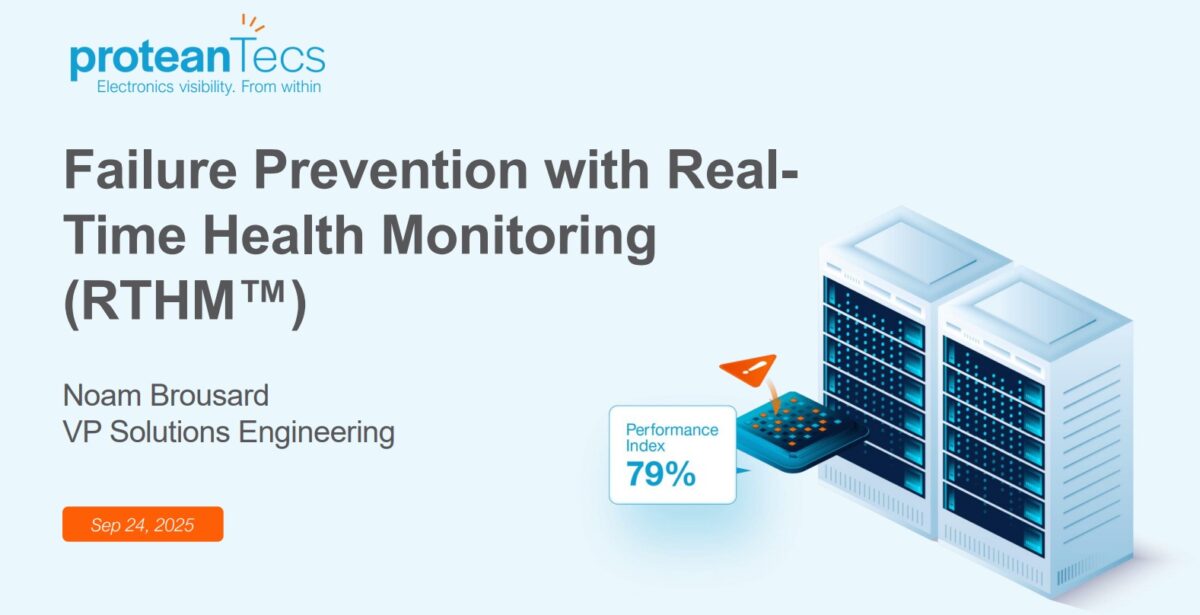Key Takeaways
- Reliability, availability, and serviceability (RAS) are critical in modern semiconductors, particularly as devices shrink to nanoscale geometries like 2nm.
- Silent data corruption (SDC) poses a significant threat in AI systems, leading to incorrect outputs and faulty decisions due to untraceable hardware failures.
- Traditional reliability approaches, such as built-in self-test (BIST), are inadequate for proactive failure prevention and often respond only after a failure occurs.
- proteanTecs’ Real-Time Health Monitoring (RTHM™) provides continuous, high-coverage monitoring of performance-limiting paths, enabling proactive intervention before failures escalate.
 are critical in modern semiconductors, particularly as devices shrink to nanoscale geometries like 2nm.
- Silent data corruption (SDC) poses a significant threat in AI systems, leading to incorrect outputs and faulty decisions due to untraceable hardware failures.
- Traditional reliability approaches, such as built-in self-test (BIST), are inadequate for proactive failure prevention and often respond only after a failure occurs.
- proteanTecs’ Real-Time Health Monitoring (RTHM™) provides continuous, high-coverage monitoring of performance-limiting paths, enabling proactive intervention before failures escalate.

In the complex world of semiconductors, reliability, availability, and serviceability (RAS) have become paramount, especially as devices shrink to nanoscale geometries like 2nm. At the recent 2025 TSMC OIP Forum Noam Brousard, VP of Solutions Engineering at proteanTecs, presented “Failure Prevention with Real-Time Health Monitoring (RTHM™),” highlighting how modern electronics face unprecedented challenges. From smaller architectures and high-performance workloads to hyper-competition and cost pressures, these factors contribute to functional failures, silent data corruption, and system-wide errors. As hardware must endure longer lifecycles, often 4-6 years, without refresh, the risk of failures escalates, particularly in large-scale AI systems where devices operate at lower voltages and under unpredictable demands.
Silent data corruption (SDC) emerges as an insidious threat. Unlike detectable errors, SDC stems from untraceable hardware failures that evade exception mechanisms and system logs. It propagates undetected, causing cascading issues that demand extensive root-cause analysis. In AI-driven environments, SDC can yield incorrect outputs, faulty decisions, and parameter corruption in models, with catastrophic implications for critical applications. Brousard cited real-world examples underscoring SDC’s rise. Meta reported miscalculated mathematical operations in defective CPUs leading to database losses, where a file decompression error produced zero instead of 156. Alibaba Cloud encountered checksum mismatches in storage apps due to intermittent processor faults. Google noted manufacturing defects exposed by rare instructions in low-level libraries, while other cases involved incorrect hashing and cache coherence issues. Studies from Google, Meta, Facebook, and Alibaba reveal that approximately one in a thousand machines in large fleets suffers from SDC, emphasizing its prevalence in production CPU populations.
Traditional approaches fall short. Built-in self-test (BIST) integrations are complex and expensive, running only at startup with slow responses and no precise location pinpointing. Hardware and software checks often react post-failure, lacking the granularity needed for proactive intervention.
proteanTecs’ RTHM, part of their comprehensive lifecycle solutions spanning power/performance optimization, reliability monitoring, functional safety, chip and system production, and advanced packaging. RTHM shifts the paradigm from error containment to failure avoidance by providing electronics visibility from within. It employs on-chip Agents for high-coverage, continuous monitoring of actual performance-limiting paths, both at test and in mission mode. These Agents sample high-speed clocks in real paths, adhering to power-performance-area (PPA) constraints, and are sensitive to workload stress, latent defects, operating conditions, DC IR drops, local Vdroops, hot spots, and aging.
A key feature is the Performance Index, an event-based algorithm that aggregates timing margin measurements across thresholds, affected areas, clock/power domains, and prior events. Analyzed per logical unit, PI delivers an integrated score reflecting issue severity—how close a device is to failure. Visualized as a percentage (e.g., 79%), it enables operators to act before problems escalate.
Without RTHM, failures manifest after escalation, complicating root causes and incurring costly downtime. With it, potential issues are identified and mitigated preemptively, yielding faster, accurate, cost-effective predictions. This proactive stance avoids functional failures, prevents SDC, and eliminates system-wide errors. RTHM offers accurate fault detection at the circuit level, reliability monitoring for intrinsic/extrinsic faults, and unmatched resiliency to halt error propagation.
Bottom line: As semiconductors push boundaries, RTHM represents a transformative tool. By embedding intelligence directly into chips, it empowers engineers to predict and avert failures, safeguarding operations in an era of scale and complexity. For more, (Need URL)
Also Read:
Podcast EP313: How proteanTecs Optimizes Production Test
Thermal Sensing Headache Finally Over for 2nm and Beyond
DAC News – proteanTecs Unlocks AI Hardware Growth with Runtime Monitoring
Share this post via: